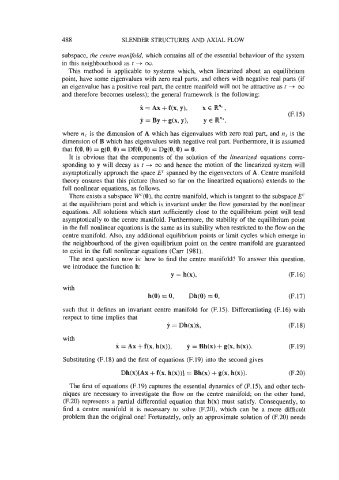Page 518 - Fluid-Structure Interactions Slender Structure and Axial Flow (Volume 1)
P. 518
488 SLENDER STRUCTURES AND AXIAL FLOW
subspace, the centre manifoZd, which contains all of the essential behaviour of the system
in this neighbourhood as t +. 00.
This method is applicable to systems which, when linearized about an equilibrium
point, have some eigenvalues with zero real parts, and others with negative real parts (if
an eigenvalue has a positive real part, the centre manifold will not be attractive as t -+ 00
and therefore becomes useless); the general framework is the following:
X = AX + f(x, y), x E R"',
(F.15)
Y = BY + g(x, Y), Y E R"',
where n, is the dimension of A which has eigenvalues with zero real part, and n, is the
dimension of B which has eigenvalues with negative real part. Furthermore, it is assumed
that f(0,O) = g(0,O) = Df(0,O) = Dg(0,O) = 0.
It is obvious that the components of the solution of the linearized equations corre-
sponding to y will decay as t -+ 00 and hence the motion of the linearized system will
asymptotically approach the space EC spanned by the eigenvectors of A. Centre manifold
theory ensures that this picture (based so far on the linearized equations) extends to the
full nonlinear equations, as follows.
There exists a subspace W'(O), the centre manifold, which is tangent to the subspace EC
at the equilibrium point and which is invariant under the flow generated by the nonlinear
equations. All solutions which start sufficiently close to the equilibrium point will tend
asymptotically to the centre manifold. Furthermore, the stability of the equilibrium point
in the full nonlinear equations is the same as its stability when restricted to the flow on the
centre manifold. Also, any additional equilibrium points or limit cycles which emerge in
the neighbourhood of the given equilibrium point on the centre manifold are guaranteed
to exist in the full nonlinear equations (Can 1981).
The next question now is: how to find the centre manifold? To answer this question,
we introduce the function h:
Y = h(x), (F. 16)
with
h(0) = 0, Dh(0) = 0, (F.17)
such that it defines an invariant centre manifold for (F.15). Differentiating (F.16) with
respect to time implies that
Y = Dh(x)X, (F.18)
with
X = AX + f(X, h(x)), jl = Bh(x) + g(X, h(x)). (F. 19)
Substituting (F.18) and the first of equations (F.19) into the second gives
Dh(x)[Ax + f(x, h(x))l = Bh(x) + g(x, h(x)). (F.20)
The first of equations (F.19) captures the essential dynamics of (F.15), and other tech-
niques are necessary to investigate the flow on the centre manifold; on the other hand,
(F.20) represents a partial differential equation that h(x) must satisfy. Consequently, to
find a centre manifold it is necessary to solve (F.20), which can be a more difficult
problem than the original one! Fortunately, only an approximate solution of (F.20) needs

